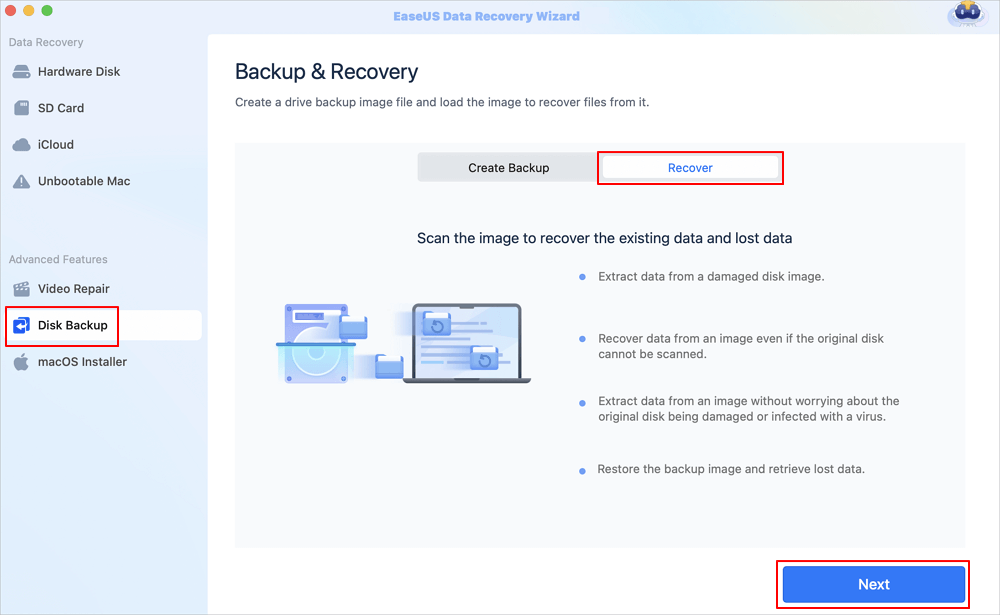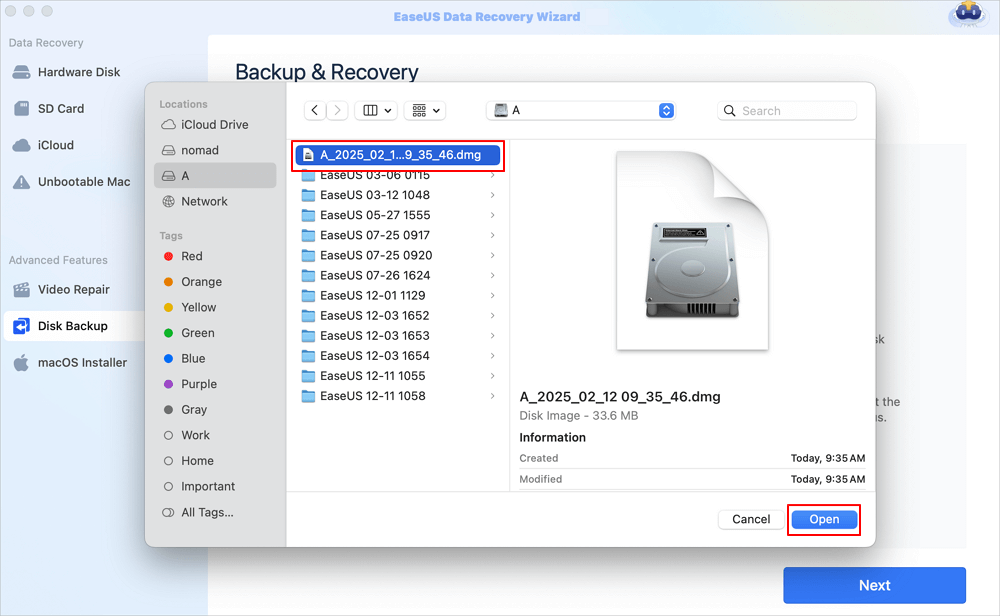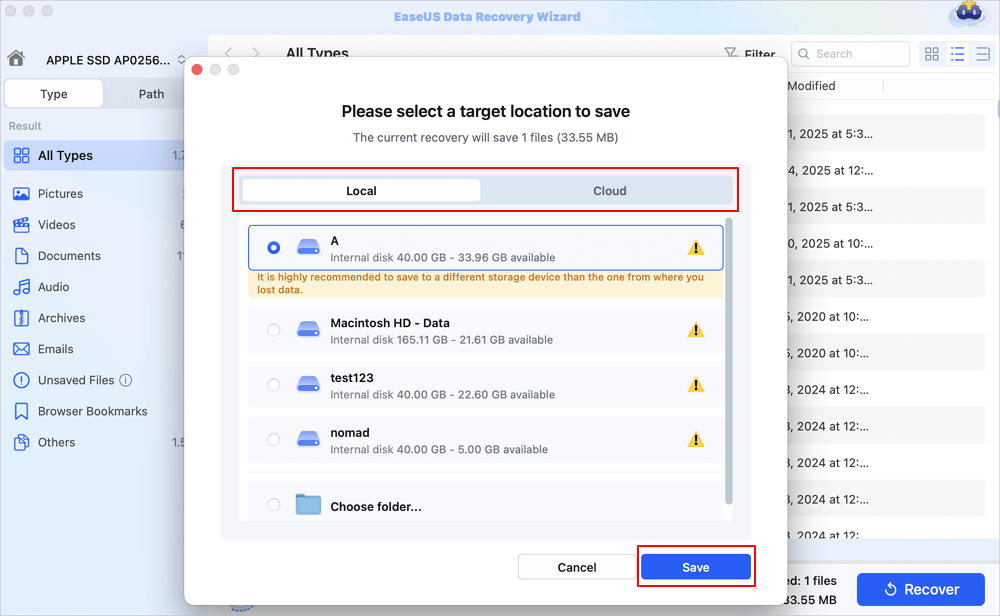Start Your Free Trial!
Sign up to our newsletter, stay updated on news and exclusive offers from EaseUS. Don't worry, if you change your mind, you can unsubscribe at any time, free of charge. We value your privacy (Privacy Policy).
Table of Contents
![]() About the Author
About the Author
![]() Reviews and Awards
Reviews and Awards
Do you worry about possible data loss from cyberattacks? Do you want to protect essential data in case the system malfunctions? The iCloud on your Mac is an excellent option in that scenario. Additionally, you can backup Mac to iCloud and restore the required files anytime you need to.
In this article, we'll go through how to set up iCloud on your MacBook and back up your data using it. If you cannot find your files on Mac, we have also prepared a bonus tip for restoring lost files to iCloud.
Apple's iCloud service securely stores your images, files, notes, passwords, and other data in the cloud and automatically syncs it with all of your devices. Sharing documents, files, notes, and other items with friends and family is also made simple via iCloud.

How to Recover Deleted Photos from iCloud on Mac
To be able to recover deleted photos on Mac from iCloud, you'll need to enable the iCloud service on your macOS device in advance. Read more >>
If you don't want to lose your precious data, then you should know how to back up your Mac to iCloud.
By default, Apple provides free storage of 5 GB on iCloud for every Apple ID. You can always buy added space on the cloud by paying a small amount. One of the best things about taking a backup on iCloud is that it can be accessed from anywhere.
Before starting, we recommend you update macOS to the latest version to avoid issues with iCloud.
Here's how to create a Mac backup using iCloud:
Step 1. Click the "Apple" icon > "System Settings".

Step 2. Select "Apple ID". In the menu on the left, choose "iCloud" if it isn't already selected. When prompted, log onto iCloud.

Step 3. If the box next to iCloud Drive isn't already ticked, click it. Additionally, iCloud Drive is adjacent to a button that says Options.
Step 3. Click "iCloud Drive" - "Options", and check the box next to anything you want to store in iCloud Drive, such as your Desktop and Documents, Messages, or Mail, then click "Done".

Step 4. Go back to the iCloud page and decide whether to back up your photos, contracts, passwords, and keychain.
Step 5. The iCloud backup of your files on your Mac will begin. Click the Manage option above the storage bar to manage your iCloud storage.

Alternatively, you can copy the material on the drive or just drag and drop a file on the drive to back up your data files.

Find Deleted Messages on MacBook (2023 Tips)
Learn how to recover deleted iMessages on Mac using Apple iPhone and iPad devices, Time Machine backup, iCloud backup. Read more >>
If the method helps resolve the issue, share it on Facebook, Twitter, Instagram, and other social media platforms!
Most Mac users are complaining about the restricted iCloud storage space. Use these suggestions in the article if you're also having trouble with the Mac space. You can choose "Optimize Mac Storage" to free up space even when you delete files on Mac but still no space.
Step 1. Click "Manage" to subscribe monthly and buy more data storage.

Step 2. To add more iCloud storage, choose "Change Storage Plan".

Step 3. Open a Finder window to view your Mac's iCloud Drive.

Step 4. After that, click the iCloud Drive folder to access it. To add a folder from your Mac to your iCloud Drive, you can drag it there or copy and paste it.
You can then use your other Apple devices to access these files after this is finished! You can rest easy knowing that your data won't be lost if something happens to your Mac because you have an iCloud backup of its data.
Did you recently encounter a nightmare of losing crucial files due to the lack of backup? Maybe, you have heard it from one of your colleagues. While regularly backing up your Mac is usually advised to prevent data loss, users occasionally experience unexpected file loss. Even imagining such a scenario is enough to drive anxiety and nervousness. Do not panic if you have also lost vital Mac data. You may easily recover your lost files with data recovery software.
Among the numerous Mac data recovery tools, we recommend you try EaseUS Data Recovery Wizard for Mac. When forgetting to backup Mac to iCloud or restore files after reinstalling macOS or Mac OS X, EaseUS Data Recovery Wizard for Mac is 100% sure to get your data back.
You are lucky if you have synced or uploaded important Mac data into iCloud before committing to a factory reset or macOS reinstallation. You can easily restore your lost files from iCloud backup.
Step 1. Launch EaseUS Data Recovery Wizard for Mac when you are ready to extract data from a disk image. Choose "Disk Backup" in the sidebar, and click "Recover" > "Next".

Step 2. Find the DMG file you have created before, and click "Open". If you save the disk image on an external hard drive, you need to connect the backup disk to your iMac/MacBook.

Step 3. EaseUS data recovery software will start scanning immediately and you can filter the lost files on the left side of the window. Choose all the photos/documents/videos/emails you want to recover, and click "Recover". You are allowed to save your files to local/cloud, and you even restore files to iCloud by clicking the "Save" button.

Knowing how to backup Mac to iCloud today makes it simple to keep your data secure. However, if you have lost your crucial data files, just use EaseUS Data Recovery Wizard for Mac's aid to recover them. It is quick, simple to use, and quite effective at helping you recover deleted data.
You have learned to backup Mac to iCloud or recover Mac data after a factory reset. To get additional help, read the questions and answers below.
1. Can I backup Mac to iCloud?
Yes. Time Machine backups do not need to include files in iCloud Drive. Your backup will be kept on your Mac and will contain the data in your iCloud Drive, and photographs in iCloud photographs because they are automatically stored in iCloud.
2. How do I know if my Mac is backed up to iCloud?
The devices that have iCloud Backup enabled are listed.
3. How do I backup my Mac photos to iCloud?
Enable iCloud Photos by going to Settings > Photos.
In addition to iCloud.com(Opens in a new window), where you may view and download pictures on a computer, this will automatically upload your library to iCloud.
4. How do I backup my computer to iCloud?
Photos, documents, notes, and other types of information from your Mac can be stored in iCloud. The entire macOS cannot, however, be saved using iCloud. You should make a Time Machine backup for this.
Was This Page Helpful?
Jaden is one of the editors of EaseUS, who focuses on topics concerning PCs and Mac data recovery. Jaden is committed to enhancing professional IT knowledge and writing abilities. She is always keen on new and intelligent products.
EaseUS Data Recovery Wizard Pro has a reputation as one of the best data recovery software programs on the market. It comes with a selection of advanced features, including partition recovery, formatted drive restoration, and corrupted file repair.
Read MoreEaseUS Data Recovery Wizard is a powerful system recovery software, designed to enable you to recover files you’ve deleted accidentally, potentially lost to malware or an entire hard drive partition.
Read MoreEaseUS Data Recovery Wizard is the best we have seen. It's far from perfect, partly because today's advanced disk technology makes data-recovery more difficult than it was with the simpler technology of the past.
Read MoreEaseUS Data Recovery Wizard Pro has a reputation as one of the best data recovery software programs on the market. It comes with a selection of advanced features, including partition recovery, formatted drive restoration, and corrupted file repair.
Read MoreEaseUS Data Recovery Wizard is a powerful system recovery software, designed to enable you to recover files you’ve deleted accidentally, potentially lost to malware or an entire hard drive partition.
Read MoreRelated Articles
Mac Pages AutoSave | Feature to Recover Unsaved Documents in Pages
![]() Brithny/Nov 27, 2024
Brithny/Nov 27, 2024
How to Recover Deleted Facebook Messages on Mac [Full Guide]
![]() Brithny/Feb 14, 2025
Brithny/Feb 14, 2025
[Solved] How to Recover Emptied Trash on Mac and Restore Deleted Files
![]() Daisy/Feb 14, 2025
Daisy/Feb 14, 2025
3 Methods: Recover Unsaved or Lost Excel File on Mac
![]() Tracy King/Feb 14, 2025
Tracy King/Feb 14, 2025
CHOOSE YOUR REGION
Start Your Free Trial!
Sign up to our newsletter, stay updated on news and exclusive offers from EaseUS. Don't worry, if you change your mind, you can unsubscribe at any time, free of charge. We value your privacy (Privacy Policy).
Start Your Free Trial!
Sign up to our newsletter, stay updated on news and exclusive offers from EaseUS. Don't worry, if you change your mind, you can unsubscribe at any time, free of charge. We value your privacy (Privacy Policy).